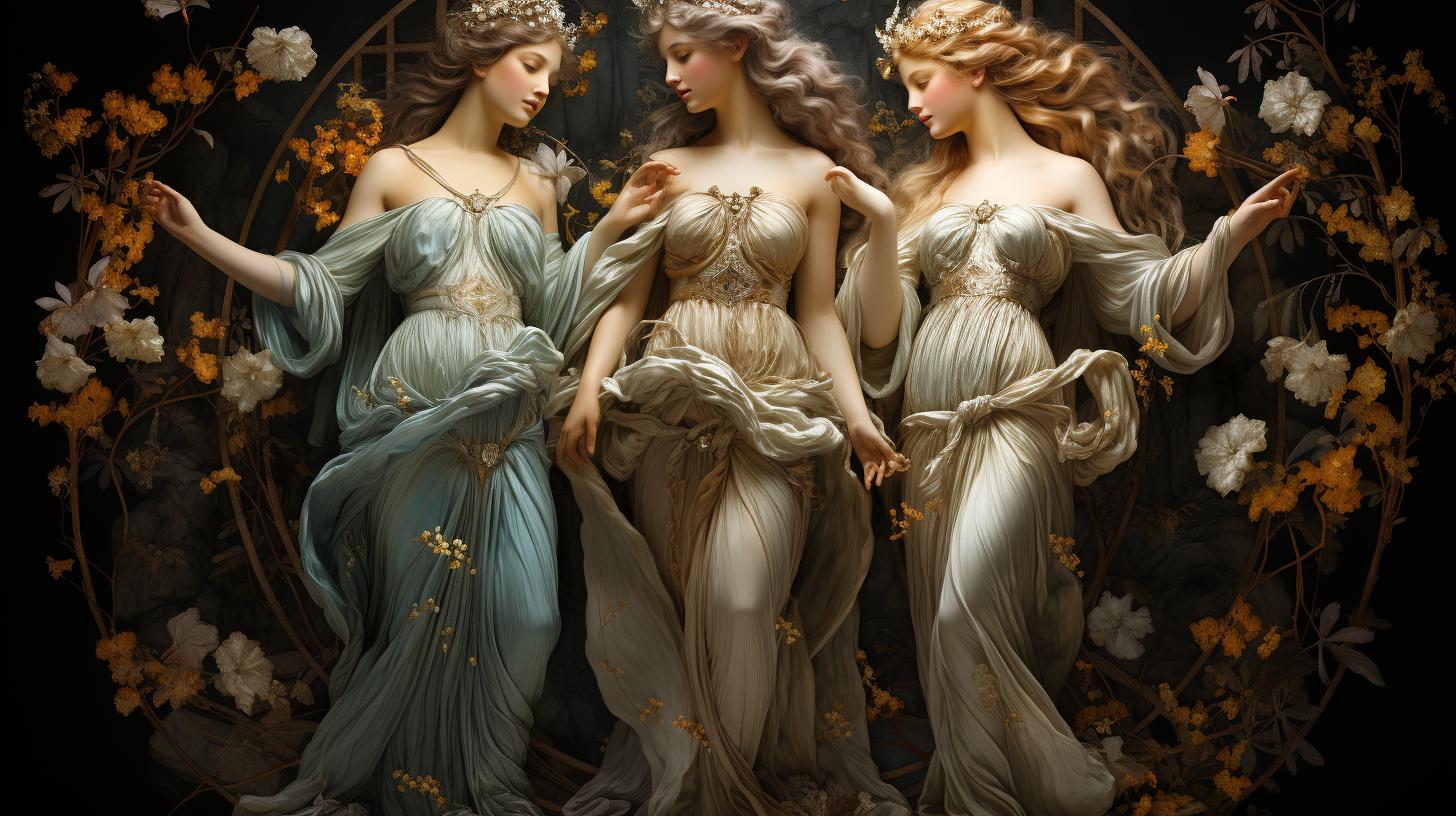The Hesperides Greek Mythology: Guardians of the Golden Apples

The Hesperides Greek mythology is a fascinating aspect of ancient Greek folklore. These divine maidens were entrusted with safeguarding a tree that bore golden apples. There are variations regarding their parentage, and their numbers are often debated.
Throughout Greek mythology, the Hesperides played significant roles, such as aiding Heracles in his quests and providing assistance to the Argonauts. The location of their abode remains a subject of speculation, and the garden they protected holds symbolic and artistic importance in various interpretations throughout history.
The Hesperides: Guardians of the Golden Apples
The Hesperides are renowned figures in Greek mythology, taking on the role of guardians for the highly sought-after golden apples. These divine maidens were entrusted with protecting a tree bearing these precious fruits, which possessed mystical powers and were considered invaluable.
The apples were believed to grant eternal youth and vitality to anyone who consumed them.
The Hesperides fulfilled their duty with utmost dedication, forming an integral part of ancient Greek folklore.
Their vigilance over the tree and its alluring fruit attracted the attention of numerous legendary heroes, gods, and mortals alike.
Their role as guardians of the golden apples ensured they were central figures in epic tales and quests.
Heroes like Heracles, also known as Hercules, faced great challenges and triumphs in their encounters with these divine maidens and their coveted apples. Their presence adds intrigue, encounters, and obstacles that contribute to the mythical narratives surrounding these legendary figures.
The significance of the Hesperides as guardians of the golden apples cannot be overstated. The allure of these fruits, their mythical properties, and the quest to possess them have captivated the imaginations of storytellers, artists, and myth enthusiasts throughout history.
The tales of the Hesperides continue to inspire and enrich our understanding of the intricate tapestry of Greek mythology.
- Distinctive role as guardians of the golden apples
- Coveted and mystical properties of the golden apples
- Legendary encounters with heroes and gods
- Intriguing obstacles and challenges faced by characters
- Inspiration for artists and mythologists
Names of the Hesperides
The Hesperides, the divine maidens of Greek mythology, were known by different names in various accounts.
This section explores the different names associated with these legendary figures and the attempts to unify them.
Unifying the Names of the Hesperides
Throughout ancient texts and narratives, the names of the Hesperides appear in diverse forms. One common trio of names includes Aegle, Eritia, and Hespere. However, other accounts suggest that their numbers could extend to seven.
Despite this variation, scholars have sought to identify the common threads and reconcile the different names given to the Hesperides in different sources.
In this effort to unify the names, researchers have explored linguistic connections and possible derivations.
They have analyzed the etymology and phonetics of the names, searching for shared roots or linguistic patterns. These investigations aim to shed light on the origins and meanings behind the various names assigned to the Hesperides.
Examples of Different Names for the Hesperides
- Aegle
- Eritia
- Hespere
- Arethusa
- Hesperethusa
- Hesperia
- Hespera
These are just some of the names associated with the Hesperides in different myths and accounts.
The quest for unifying these names provides insights into the rich tapestry of Greek mythology and the intricate web of narratives surrounding these mythical figures.
Origins of the Hesperides
The Hesperides, guardians of the golden apples, have diverse theories surrounding their origins. Let’s explore the parentage of the Hesperides and the alternative theories related to their birth.
The Parentage of the Hesperides: Erebus and Nyx
According to one belief, the Hesperides were born to the divine couple Erebus and Nyx. Erebus symbolized the darkness and Nyx represented the night.
This lineage connects the Hesperides directly to the primordial forces of the cosmos, emphasizing their divine nature.
Alternative Parentage Theories: Atlas and Hesperis, Phorcys and Ceto
In addition to the parentage of Erebus and Nyx, alternative theories suggest different origins for the Hesperides. Some accounts propose that they were the children of Atlas and Hesperis, while others claim Phorcys and Ceto as their parents.
These variations reflect the complexity of mythology and the multiple ways in which ancient Greek scholars interpreted and reshaped their narratives over time.
Understanding the origins of the Hesperides provides insights into their divine lineage and establishes their significance within Greek mythology.
These diverse theories showcase the richness and complexity of ancient myths, offering different perspectives on the origins of these divine maidens.
Hesperides in Greek Mythology
In Greek mythology, the Hesperides played a significant role as divine maidens tasked with protecting a tree that bore golden apples. They were portrayed as guardians of this mythical garden, serving as custodians of its treasures.
Their duty was to ensure that the golden apples remained untouched and safe from harm.
The Hesperides and the Golden Apples
One of the primary responsibilities of the Hesperides was the guardianship of the coveted golden apples. These apples possessed a divine quality, often associated with immortality or eternal youth. The Hesperides’ role was crucial in safeguarding these precious fruits, preventing any unauthorized access.
The Hesperides in the Labors of Heracles
The Hesperides were directly involved in one of the famous labors of the mythical hero, Heracles. As part of his tasks, Heracles was assigned to retrieve the golden apples.
To accomplish this, he had to defeat Ladon, a fearsome dragon who guarded the tree. With his strength and bravery, Heracles successfully overcame the challenges posed by the Hesperides.
The Hesperides and Aphrodite’s Apples for Hippomenes
Another mention of the Hesperides and their golden apples can be found in the love story of Aphrodite and Hippomenes.
It is believed that the apples used by Aphrodite, the goddess of love, to aid Hippomenes in his pursuit of Atalanta were from the garden of the Hesperides. These magical apples played a pivotal role in helping Hippomenes win the race and claim his love.
The Hesperides’ Assistance to the Argonauts
The Hesperides also assisted the legendary group of heroes, the Argonauts, during their quests. In their journey, the Argonauts faced challenges and hardships, including thirst. The Hesperides revealed a miraculous water source to the Argonauts, calming their thirst and providing them with the strength to continue their voyage.
In return, the Argonauts promised to honor the Hesperides with abundant libations and feasts.
Location of the Hesperides
In the captivating realm of Greek mythology, the elusive location of the Hesperides, the divine guardians of the golden apples, has intrigued scholars for centuries. According to various theories, their whereabouts have been speculated to exist in two distinct regions: North Africa and the enigmatic Hyperborean realm.
Proposals for the Hesperides’ Location: North Africa, Hyperborean Region
One school of thought suggests that the mythical Hesperides resided in the enchanting lands of North Africa. This theory points to the ancient Berber territory, believed to have been home to these divine maidens.
Some argue that the Atlas Mountains, extending through present-day Morocco and Algeria, held the legendary garden.
On the other hand, another intriguing hypothesis places the Hesperides in the elusive realm of the Hyperboreans.
This mystical Northern land beyond the known world was said to be abundant in celestial wonders. Some adventure-seeking scholars propose that the garden of the Hesperides flourished in this ethereal domain where the setting sun kissed the horizon, bathing the landscape in an otherworldly glow.
The Hesperides and the Setting Sun
The Hesperides’ close association with the setting sun adds another layer of mystery to their fabled location. Legends describe these divine maidens as dwellers of the far west, where the sun bids its daily farewell.
This mesmerizing connection between the Hesperides and the setting sun has led to speculations that their mythical garden may have been situated on the westernmost edges of the known world.
As the sun dipped below the horizon, myth and reality intertwined, enveloping the fabled land of the Hesperides in an aura of enchantment.
Artists throughout history have sought to capture this mystical interplay of light and shadow, illustrating the ethereal qualities of the Hesperides’ realm.
However, the exact location of the Hesperides, whether nestled in the picturesque landscapes of North Africa or in the mystical Hyperborean realm, continues to be a subject of scholarly debate and interpretation.
- Hypothesized locations include ancient Berber territory in North Africa.
- Speculations also point to the enigmatic realm of the Hyperboreans.
- The Hesperides’ connection to the setting sun lends an air of mystery to their location.
- Artists have sought to capture the enchanting qualities of the Hesperides’ realm.
- Their exact whereabouts remain a subject of scholarly debate.
Interpretation and Symbolism of the Garden of the Hesperides
The garden of the Hesperides holds a significant place in Greek mythology, offering various layers of interpretation and symbolism.
It has captured the imagination of artists and scholars alike, giving rise to different perspectives on its meaning and historical significance.
The Mythological Significance of the Garden
The garden of the Hesperides is a realm shrouded in myths and legends. It symbolizes a sacred space where divine treasures, such as the golden apples, are guarded. The garden represents a mythical paradise, an utopian sanctuary that embodies the beauty, fertility, and abundance of nature.
Within Greek mythology, the garden stands as a liminal space, existing at the boundary between mortals and the divine. Its inclusion in tales of gods and heroes highlights its role as a site of transformation, adventure, and discovery.
Historical Interpretations of the Garden
Throughout history, the garden of the Hesperides has been interpreted in various ways, reflecting shifting cultural contexts and the evolving understanding of Greek mythology. Some scholars see the garden as a symbol of the natural world, where the divine and earthly realms merge.
Others view it as an allegory for the pursuit of knowledge, wisdom, and enlightenment, drawing parallels to ancient gardens and philosophical traditions. The garden’s golden apples, representing divine wisdom, were sought after by figures such as Heracles and Perseus, symbolizing their quest for immortality and enlightenment.
Artistic Depictions of the Garden in History
The garden of the Hesperides has inspired countless artworks throughout history, from ancient Greek pottery to Renaissance paintings and modern sculptures. Artists have depicted the garden’s lush vegetation, exotic creatures, and the divine maidens themselves.
These artistic depictions often emphasize the garden’s mythical qualities, emphasizing its ethereal beauty and the divine presence that surrounds it. The imagery associated with the garden has influenced artistic representations of nature, femininity, and the concept of paradise.
- The garden’s abundant flora and fauna have become symbols of fertility, growth, and the awe-inspiring power of nature.
- The Hesperides, with their divine grace and alluring beauty, have come to embody femininity, enchantment, and the protective role of women.
- The golden apples have taken on multifaceted meanings, representing knowledge, temptation, and the pursuit of immortality.
These artistic interpretations reflect not only the fascination with the garden but also the cultural and societal values of the time, allowing the garden of the Hesperides to continue inspiring artistic creations even in the modern era.
As we explore the mythical significance, historical interpretations, and artistic representations of the garden of the Hesperides, we gain deeper insights into the profound symbolism and enduring allure of this mythical paradise.
.




















